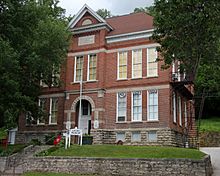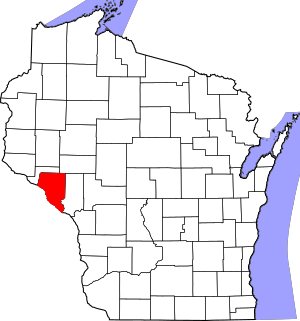Buffalo County, Wisconsin facts for kids
Quick facts for kids
Buffalo County
|
|
|---|---|

Alma Area Museum in Old Buffalo County Training School and Teachers College Building in Alma, Wisconsin.
|
|

Location within the U.S. state of Wisconsin
|
|
 Wisconsin's location within the U.S. |
|
| Country | |
| State | |
| Founded | 1854 |
| Named for | Buffalo River |
| Seat | Alma |
| Largest city | Mondovi |
| Area | |
| • Total | 710 sq mi (1,800 km2) |
| • Land | 672 sq mi (1,740 km2) |
| • Water | 38 sq mi (100 km2) 5.3% |
| Population
(2020)
|
|
| • Total | 13,317 |
| • Estimate
(2023)
|
13,419 |
| • Density | 19.7/sq mi (7.6/km2) |
| Time zone | UTC−6 (Central) |
| • Summer (DST) | UTC−5 (CDT) |
| Congressional district | 3rd |
Buffalo County is a county found in the state of Wisconsin. In 2020, about 13,317 people lived there. Its main town, or county seat, is Alma. The county was officially created in 1853.
Contents
History of Buffalo County
Buffalo County was named after the Buffalo River. This river flows from Strum to Alma, where it joins the Mississippi River. A French explorer named Father Louis Hennepin gave the river its name, Riviere des Boeufs, in 1680. This means "River of Buffaloes."
The first lasting settlement in the area began in 1839. It was in what is now Fountain City. This place was first called Holmes' Landing. It was named after a family who traded with the Sioux and Chippewa Native American tribes.
Many immigrants from Switzerland, Germany, and Norway moved to Buffalo County. They came because of the growing lumber (wood) industry. They also liked the rich soil, easy access to the Mississippi River, and available land. By 1848, another community called Twelve Mile Bluff was started. Today, this town is known as Alma.
Farming and Growth
Farming started to grow in the 1850s. Farmers found it easier to work the land on top of the ridges. These areas had natural prairies (grasslands) and oak savannas (areas with scattered trees). At first, there were not many good roads. So, people settled along the Mississippi River. This way, farmers could ship their crops using steamboats.
Later, the Northern Rail train line was built from Winona, Minnesota. This allowed towns to grow away from the river. By 1890, most farmers were sending their goods by train.
The Civil War (1861-1865) helped the local economy. There was a high demand for wheat, which was the county's main crop. After the war, many new settlers arrived. However, the soil became less fertile. Many farmers moved west instead of learning new farming methods. These methods included crop rotation (changing crops each year) and fertilization (adding nutrients to the soil).
When wheat prices dropped, farmers started dairy farming. This means raising cows for milk and cheese. By the 1880s, local creameries (places where milk is processed) began to appear.
Geography of Buffalo County
Buffalo County covers about 710 square miles. Most of this (672 square miles) is land. About 38 square miles (5.3%) is covered by water.
Nearby Counties
- Pepin County – to the north
- Eau Claire County – to the northeast
- Trempealeau County – to the east
- Winona County, Minnesota – to the south
- Wabasha County, Minnesota – to the west
Main Roads
Train Lines
Population Information
| Historical population | |||
|---|---|---|---|
| Census | Pop. | %± | |
| 1860 | 3,864 | — | |
| 1870 | 11,123 | 187.9% | |
| 1880 | 15,528 | 39.6% | |
| 1890 | 15,997 | 3.0% | |
| 1900 | 16,765 | 4.8% | |
| 1910 | 16,006 | −4.5% | |
| 1920 | 15,615 | −2.4% | |
| 1930 | 15,330 | −1.8% | |
| 1940 | 16,090 | 5.0% | |
| 1950 | 14,719 | −8.5% | |
| 1960 | 14,202 | −3.5% | |
| 1970 | 13,743 | −3.2% | |
| 1980 | 14,309 | 4.1% | |
| 1990 | 13,584 | −5.1% | |
| 2000 | 13,804 | 1.6% | |
| 2010 | 13,587 | −1.6% | |
| 2020 | 13,317 | −2.0% | |
| U.S. Decennial Census 1790–1960 1900–1990 1990–2000 2010 2020 |
|||
2020 Census Details
In 2020, the county had 13,317 people. This means there were about 19.7 people for every square mile. There were 6,506 homes.
Most people in the county (95.0%) were White. A small number were Black or African American (0.3%), Native American (0.3%), or Asian (0.2%). About 2.5% of the population was Hispanic or Latino.
Towns and Villages
Cities
- Alma (this is the county seat)
- Buffalo City
- Fountain City
- Mondovi
Villages
Towns
Census-Designated Places
These are areas that are like towns but are not officially incorporated.
Other Small Communities
Train Junctions
Old or Abandoned Towns
Famous People
- Chauncey H. Cooke (1846–1919), an American soldier who fought in the U.S. Civil War.
See also
 In Spanish: Condado de Buffalo (Wisconsin) para niños
In Spanish: Condado de Buffalo (Wisconsin) para niños

